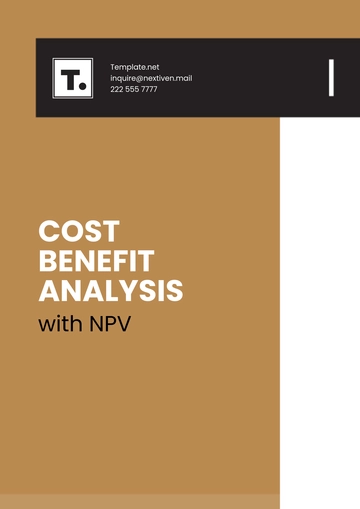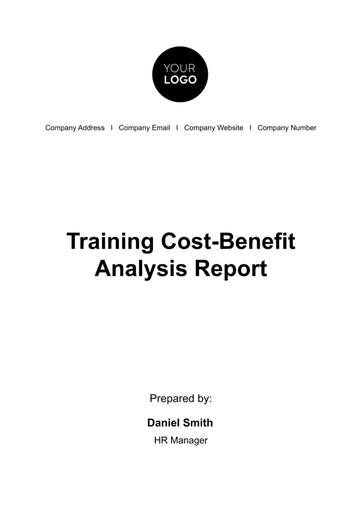Free Restaurant Financial Analysis

Prepared By: | [YOUR NAME] |
Company: | [YOUR COMPANY NAME] |
Department: | [YOUR DEPARTMENT] |
I. Executive Summary
A. Overview
This analysis entails a detailed examination of a restaurant's financial performance. It involves reviewing financial statements, such as income statements, balance sheets, and cash flow statements, to assess profitability, cost management, and overall financial health. The analysis helps identify trends, areas for improvement, and growth opportunities, providing a comprehensive overview of the restaurant’s economic status.
B. Key Findings
Profitability: Evaluation of revenue streams and profit margins.
Cost Management: Assessment of expenses and cost-saving measures.
Financial Health: Analysis of liquidity, solvency, and efficiency ratios.
II. Introduction
A. Purpose
To provide a comprehensive overview of the financial performance of [Your Company Name] and offer insights into its economic status.
B. Scope
This analysis covers a review of financial statements, trend analysis, benchmarking against industry standards, and recommendations for improvement.
III. Financial Statements Review
A. Income Statement Analysis
Revenue: Total income generated from sales.
Cost of Goods Sold (COGS): Direct costs associated with producing goods sold.
Gross Profit: Revenue minus COGS.
Operating Expenses: Costs incurred in running the business, excluding COGS.
Net Income: Total profit after subtracting all expenses from revenue.
B. Balance Sheet Analysis
Assets: Resources owned by the restaurant, including cash, inventory, and property.
Liabilities: Debts owed by the restaurant to creditors.
Equity: Owner's stake in the business, calculated as assets minus liabilities.
C. Cash Flow Statement Analysis
Operating Activities: Cash flows from day-to-day operations.
Investing Activities: Cash flows from buying and selling assets.
Financing Activities: Cash flows from borrowing, repaying debt, and issuing equity.
IV. Financial Performance Metrics
A. Profitability Ratios
Gross Profit Margin: Gross profit divided by revenue, indicating production efficiency.
Net Profit Margin: Net income divided by revenue, reflecting overall profitability.
Return on Investment (ROI): Net profit divided by total investment, measuring profitability relative to investment.
B. Liquidity Ratios
Current Ratio: Current assets divided by current liabilities, assessing short-term liquidity.
Quick Ratio: (Current assets minus inventory) divided by current liabilities, a more stringent measure of liquidity.
C. Solvency Ratios
Debt-to-Equity Ratio: Total debt divided by total equity, indicating the extent of leverage.
Interest Coverage Ratio: Earnings before interest and taxes (EBIT) divided by interest expense, assessing the ability to meet interest obligations.
D. Efficiency Ratios
Inventory Turnover: Cost of goods sold divided by average inventory, measuring efficiency in managing inventory.
Asset Turnover: Revenue divided by total assets, indicating how efficiently assets are used to generate sales.
V. Trend Analysis
A. Revenue Trend
Examination of revenue growth or decline over multiple periods.
Identification of seasonal or cyclical patterns affecting revenue.
B. Expense Trend
Analysis of trends in operating expenses and cost of goods sold.
Identification of cost-saving opportunities or areas of overspending.
C. Profitability Trend
Assessment of changes in gross profit margin and net profit margin.
Evaluation of the effectiveness of cost management strategies.
VI. Recommendations
A. Cost Reduction Strategies
Implementing inventory management systems to minimize waste.
Negotiating better terms with suppliers to lower procurement costs.
B. Revenue Enhancement Strategies
Introducing new menu items to attract more customers.
Launching targeted marketing campaigns to increase sales.
C. Operational Efficiency Improvements
Streamlining processes to reduce labor costs and improve productivity.
Investing in technology solutions to automate routine tasks.
VII. Conclusion
A. Summary
This financial performance analysis provides valuable insights into the strengths, weaknesses, and opportunities for [Your Company Name]. By examining key financial metrics and trends, stakeholders can make informed decisions to improve profitability and sustainability.
B. Next Steps
Implementation of Recommendations: Execute identified strategies to enhance financial performance.
Regular Monitoring: Continuously monitor financial metrics and adjust strategies as needed.
External Benchmarking: Compare performance against industry peers to identify areas for further improvement.
- 100% Customizable, free editor
- Access 1 Million+ Templates, photo’s & graphics
- Download or share as a template
- Click and replace photos, graphics, text, backgrounds
- Resize, crop, AI write & more
- Access advanced editor
Streamline your restaurant's financial planning with the Restaurant Financial Analysis Template from Template.net. Fully customizable and editable, this template helps you monitor expenses, revenue, and profitability. Effortlessly editable in our AI Editor, too, ensuring precision and ease. Take control of your financial data and make informed decisions with this indispensable tool.





























